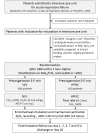Preoxygenation with non-invasive ventilation versus high-flow nasal cannula oxygen therapy for intubation of patients with acute hypoxaemic respiratory failure in ICU: the prospective randomised controlled FLORALI-2 study protocol
- PMID: 29275345
- PMCID: PMC5770951
- DOI: 10.1136/bmjopen-2017-018611
Preoxygenation with non-invasive ventilation versus high-flow nasal cannula oxygen therapy for intubation of patients with acute hypoxaemic respiratory failure in ICU: the prospective randomised controlled FLORALI-2 study protocol
Abstract
Introduction: Endotracheal intubation in intensive care unit (ICU) is a procedure at high risk of life-threatening complications. Among them, severe oxygen desaturation, usually defined as a drop of pulse oxymetry (SpO2) below 80%, is the most common. Preoxygenation enables delaying oxygen desaturation occurring during apnea induced by anaesthetic drugs. Data suggest that non-invasive ventilation (NIV) or high-flow nasal cannula (HFNC) oxygen therapy could further increase PaO2 before intubation procedure and prevent oxygen desaturation episodes as compared with standard oxygen. However, no recommendation favours one technique rather than the other, since they have never been compared. Hence, whether a strategy of preoxygenation with NIV or HFNC is more effective than the other in patients with acute hypoxaemic respiratory failure remains to be established.
Methods and analysis: The FLORALI-2 study is a multicentre randomised controlled trial comparing a preoxygenation strategy with either NIV or HFNC in patients with acute hypoxaemic respiratory failure needing intubation in ICU. The 320 patients will be randomised with a ratio 1:1 in two groups according to the strategy of preoxygenation. The primary outcome is the occurrence of an episode of severe oxygen desaturation defined by a drop of SpO2 below 80% during the intubation procedure. Secondary outcomes include feasibility of the two strategies, immediate and late complications related to intubation.
Ethics and dissemination: The study has been approved by the central ethics committee (Ethics Committee Ouest-III, Poitiers, France) and patients will be included after informed consent. The results will be submitted for publication in peer-reviewed journals.
Trial registration number: NCT02668458; Pre-results.
Keywords: adult thoracic medicine; clinical trials.
© Article author(s) (or their employer(s) unless otherwise stated in the text of the article) 2017. All rights reserved. No commercial use is permitted unless otherwise expressly granted.
Conflict of interest statement
Competing interests: J-PF reports consulting fees from Fisher and Paykel. J-DR reports travel expenses coverage to attend scientific meetings by Fisher & Paykel.
Figures


References
Publication types
MeSH terms
Associated data
LinkOut - more resources
Full Text Sources
Other Literature Sources
Medical
